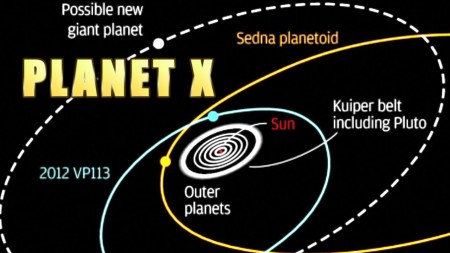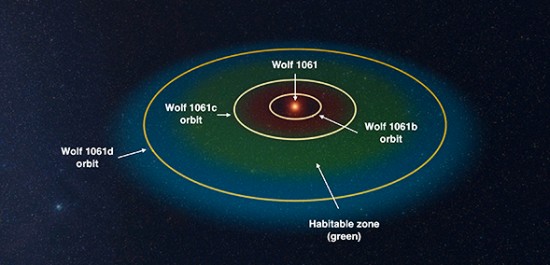December 18, 2015 – Two planet stories this week caught my eye. The first may expand the number of known planets in our Solar System. And the second adds another exoplanet to the growing stable of potential Earths with this one a mere 14 light-years away.
The Search for Planet X May Have Found a Candidate
Astronomers from the late-19th century onward have always been puzzled by perturbations in the orbits of the two outer gas giants in our Solar System. In fact it was weird aspects of Uranus’ orbit that led to the discovery of Neptune in 1846. Then Neptune orbit irregularities led to a search for a ninth planet with Clyde Tombaugh identifying Pluto in 1930 as “Planet X.” But Pluto, as we know today, is a dwarf planet, not nearly massive enough to explain the anomalies in Neptune’s annual path around the Sun. So that’s why astronomers have continued to seek a gas giant or super Earth beyond Neptune.
In the last week astronomers at the ALMA radio telescope located in the Atacama Desert of Chile, detected what they believe may be a single incident view of Planet X or potentially two candidates lurking in the outer Solar System. Their research has been submitted to the the journal, Astronomy & Astrophysics subject to peer review.
The mysterious object appeared in proximity to Alpha Centauri in the night sky during an ALMA scan. Alpha Centauri is part of a suspected triple star system and second closest to us here in the Solar System. But identifying the object by location hasn’t given us distance location. In their paper the astronomers paint two likely scenarios:
- it could be a previously undiscovered Kuiper Belt object ranging in size between 218 kilometers (136 miles) and approximately 880 kilometers (546 miles) in diameter with location between 1.77 billion kilometers (1.1 billion miles) and 3.7 billion kilometers (2.3 billion miles) from the Sun.
- or it could be much larger and farther away, a rogue gas giant or super-Earth as far distant as 600 billion kilometers (372 billion miles) from the Sun and not gravitationally tied to our Solar System.
The discoverers have called their finding Gna. Will further searches for this Planet X candidate provide proof? Let’s wait and see.
NASA has used the Wide-field Infrared Survey Explorer space telescope on sky surveys and found no signs of any gas giants equivalent to Jupiter in size lurking anywhere within three trillion kilometers of the Sun. And they have found nothing Saturn-sized within 1.5 trillion. That doesn’t rule out finding a super-Earth which Gna might be once others have corroborated the evidence from Atacama by making similar observations from other sites and instruments.
Goldilocks Planet Discovered 14 Light Years Away
University of New South Wales astronomers announced a new member of the habitable planet club found outside our Solar System. The planet is part of the Wolf 1061 star system, an M or red dwarf. The planet is one of three rocky planets orbiting the star and sits within the Goldilocks Zone where water can exist in liquid form on its surface. The planet, designated Wolf 1061c has a mass 4.3 times that of Earth and an annual orbit of a mere 18 days.
Why such a short orbit? Red dwarf stars are smaller and cooler than our Sun and hence for a planet to lie within a habitable zone it must be much closer to its star than Earth is to ours.
A paper outlining the discovery has been submitted to The Astrophysical Journal for peer review. Because of the star’s proximity to Earth astronomers should in years to come be able to study Wolf 1061c’s atmospheric composition. If we detect free oxygen in the atmosphere that would be the discovery of the century.











